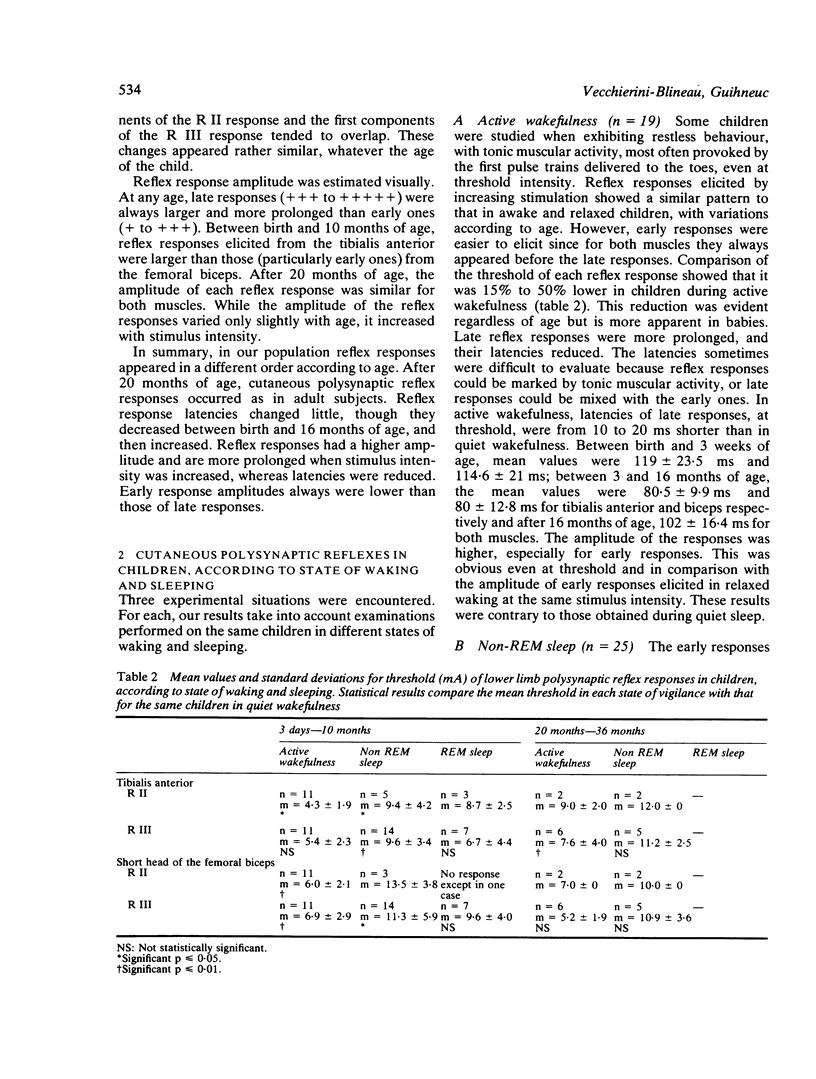Abstract
An electromyographic study of reflex responses elicited by stimulation of an area of skin in the lower limb was undertaken in awake or sleeping children from 3 days to 3 years of age. Recordings were made on the tibialis anterior and the short head of the femoral biceps. In the awake child, electrical stimulation of the cutaneous area around the toes evoked polysynaptic discharges (R II and R III) in both muscles. From birth to one year of age, the threshold for the tibialis anterior was much lower than for the short head of biceps, and the flexion reflex pattern predominated. After 20 months of age, the recruitment pattern for polysynaptic responses was different: the threshold for tibialis anterior increased and became higher than for the short head of biceps, as in the adult. In sleeping children, the most striking feature was the depression of R II responses. In non-REM sleep, R III responses also were depressed, with a similar threshold in both muscles, and even disappeared during deep sleep. In REM sleep, R III responses were present in babies, but seemed to be abolished in older children.
Full text
PDF







Selected References
These references are in PubMed. This may not be the complete list of references from this article.
- BLOM S., HAGBARTH K. E., SKOGLUND S. POST-TETANIC POTENTIATION OF H-REFLEXES IN HUMAN INFANTS. Exp Neurol. 1964 Mar;9:198–211. doi: 10.1016/0014-4886(64)90017-2. [DOI] [PubMed] [Google Scholar]
- BRAIN R., WILKINSON M. Observations on the extensor plantar reflex and its relationship to the functions of the pyramidal tract. Brain. 1959 Sep;82:297–320. doi: 10.1093/brain/82.3.297. [DOI] [PubMed] [Google Scholar]
- Bathien N., Bourdarias H. Lower limb cutaneous reflexes in hemiplegia. Brain. 1972;95(3):447–456. doi: 10.1093/brain/95.2.447. [DOI] [PubMed] [Google Scholar]
- CARPENTER D., LUNDBERG A., NORRSELL U. PRIMARY AFFERENT DEPOLARIZATION EVOKED FROM THE SENSORIMOTOR CORTEX. Acta Physiol Scand. 1963 Sep-Oct;59:126–142. doi: 10.1111/j.1748-1716.1963.tb02729.x. [DOI] [PubMed] [Google Scholar]
- Dimitrijević M. R., Nathan P. W. Studies of spasticity in man. 3. Analysis of revlex activity evoked by noxious cutaneous stimulation. Brain. 1968 Jun;91(2):349–368. doi: 10.1093/brain/91.2.349. [DOI] [PubMed] [Google Scholar]
- Fujiki A., Shimizu A., Yamada Y., Yamamoto J., Kaneko Z. The Babinski reflex during sleep and wakefulness. Electroencephalogr Clin Neurophysiol. 1971 Dec;31(6):610–613. doi: 10.1016/0013-4694(71)90077-0. [DOI] [PubMed] [Google Scholar]
- Gutrecht J. A., Dyck P. J. Quantitative teased-fiber and histologic studies of human sural nerve during postnatal development. J Comp Neurol. 1970 Jan;138(1):117–129. doi: 10.1002/cne.901380109. [DOI] [PubMed] [Google Scholar]
- HAGBARTH K. E. Excitatory and inhibitory skin areas for flexor and extensor motoneurons. Acta Physiol Scand Suppl. 1952;26(94):1–58. [PubMed] [Google Scholar]
- HAGBARTH K. E. Spinal withdrawal reflexes in the human lower limbs. J Neurol Neurosurg Psychiatry. 1960 Aug;23:222–227. doi: 10.1136/jnnp.23.3.222. [DOI] [PMC free article] [PubMed] [Google Scholar]
- Hogan G. R., Milligan J. E. The plantar reflex of the newborn. N Engl J Med. 1971 Aug 26;285(9):502–503. doi: 10.1056/NEJM197108262850907. [DOI] [PubMed] [Google Scholar]
- Hugon M. Effets réflexes et perceptifs de la stimulation électrique du nerf sural. Actual Neurophysiol (Paris) 1972;9(0):23–46. [PubMed] [Google Scholar]
- KUGELBERG E., EKLUND K., GRIMBY L. An electromyographic study of the nociceptive reflexes of the lower limb. Mechanism of the plantar responses. Brain. 1960 Sep;83:394–410. doi: 10.1093/brain/83.3.394. [DOI] [PubMed] [Google Scholar]
- Katiyar G. P., Sen S., Agarwal K. N. Plantar response during infancy. Acta Neurol Scand. 1976 May;53(5):390–394. doi: 10.1111/j.1600-0404.1976.tb04357.x. [DOI] [PubMed] [Google Scholar]
- LANDAU W. M., CLARE M. H. The plantar reflex in man, with special reference to some conditions where the extensor response is unexpectedly absent. Brain. 1959 Sep;82:321–355. doi: 10.1093/brain/82.3.321. [DOI] [PubMed] [Google Scholar]
- LUNDBERG A., VOORHOEVE P. Effects from the pyramidal tract on spinal reflex arcs. Acta Physiol Scand. 1962 Nov-Dec;56:201–219. doi: 10.1111/j.1748-1716.1962.tb02498.x. [DOI] [PubMed] [Google Scholar]
- Lenard H. G., von Bernuth H., Prechtl H. F. Reflexes and their relationship to behavioural state in the newborn. Acta Paediatr Scand. 1968 May;57(3):177–185. doi: 10.1111/j.1651-2227.1968.tb04676.x. [DOI] [PubMed] [Google Scholar]
- Lenzi G. L., Pompeiano O., Rabin B. Supraspinal control of transmission in the polysynaptic reflex pathway to montoneurones during sleep. Pflugers Arch Gesamte Physiol Menschen Tiere. 1968;301(4):311–319. doi: 10.1007/BF00362641. [DOI] [PubMed] [Google Scholar]
- Pompeiano O., Morrison A. R. Vestibular influences during sleep. I. Abolition of the rapid eye movements of desynchronized sleep following vestibular lesions. Arch Ital Biol. 1965 Dec 10;103(4):569–595. [PubMed] [Google Scholar]
- Prechtl H. F., Vlach V., Lenard H. G., Grant D. K. Exteroceptive and tendon reflexes in various behavioural states in the newborn infant. Biol Neonat. 1967;11(3):159–175. doi: 10.1159/000240063. [DOI] [PubMed] [Google Scholar]
- Shahani B. T., Young R. R. Human flexor reflexes. J Neurol Neurosurg Psychiatry. 1971 Oct;34(5):616–627. doi: 10.1136/jnnp.34.5.616. [DOI] [PMC free article] [PubMed] [Google Scholar]
- Shahani B. Effects of sleep on human reflexes with a double component. J Neurol Neurosurg Psychiatry. 1968 Dec;31(6):574–579. doi: 10.1136/jnnp.31.6.574. [DOI] [PMC free article] [PubMed] [Google Scholar]
- Shahani B. Flexor reflex afferent nerve fibres in man. J Neurol Neurosurg Psychiatry. 1970 Dec;33(6):786–791. doi: 10.1136/jnnp.33.6.786. [DOI] [PMC free article] [PubMed] [Google Scholar]
- Sherrington C. S. Flexion-reflex of the limb, crossed extension-reflex, and reflex stepping and standing. J Physiol. 1910 Apr 26;40(1-2):28–121. doi: 10.1113/jphysiol.1910.sp001362. [DOI] [PMC free article] [PubMed] [Google Scholar]
- Vecchierini-Blineau M. F., Guiheneuc P. Electrophysiological study of the peripheral nervous system in children. Changes in proximal and distal conduction velocities from birth to age 5 years. J Neurol Neurosurg Psychiatry. 1979 Aug;42(8):753–759. doi: 10.1136/jnnp.42.8.753. [DOI] [PMC free article] [PubMed] [Google Scholar]
- Vecchierini-Blineau M. F., Guiheneuc P. Excitability of the monosynaptic reflex pathway in the child from birth to four years of age. J Neurol Neurosurg Psychiatry. 1981 Apr;44(4):309–314. doi: 10.1136/jnnp.44.4.309. [DOI] [PMC free article] [PubMed] [Google Scholar]
- Vlach V., von Bernuth H., Prechtl H. F. State dependency of exteroceptive skin reflexes in newborn infants. Dev Med Child Neurol. 1969 Jun;11(3):353–362. doi: 10.1111/j.1469-8749.1969.tb01442.x. [DOI] [PubMed] [Google Scholar]
- WALSHE F. The Babinski plantar response, its forms and its physiological and pathological significance. Brain. 1956 Dec;79(4):529–556. doi: 10.1093/brain/79.4.529. [DOI] [PubMed] [Google Scholar]


